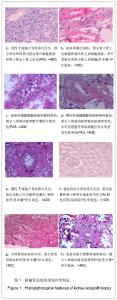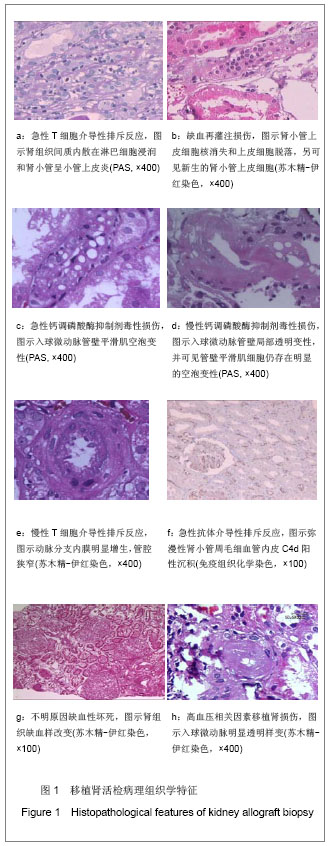| [1] Randhawa PS, Schonder K, Shapiro R,et al. Polyomavirus BK neutralizing activity in human immunoglobulin preparations.Transplantation. 2010;89(12):1462-1465.[2] Guo H,Wang Y,Lin ZB,et al.Zhonghua Qiguan Yizhi Zazhi. 2001;22(2):82-84.郭晖,王莺,林正斌,等.移植肾活组织检查191例的病理学研究[J].中华器官移植杂志,2001,22(2):82-84.[3] Zhang ZH,Na YQ,Guo YL.Guowai Yixue:Yizhi yu Xueye Jinghua Fence. 2004;2(3):8-10.张志宏,那彦群,郭应禄.肾移植排斥反应诊断方法的进展[J].国外医学:移植与血液净化分册,2004,2(3):8-10.[4] Obeidat MA, Luyckx VA, Grebe SO,et al. Post-transplant nuclear renal scans correlate with renal injury biomarkers and early allograft outcomes.Nephrol Dial Transplant. 2011;26(9): 3038-3045.[5] Renoult E, Coutlée F, Pâquet M,et al. Evaluation of a preemptive strategy for BK polyomavirus-associated nephropathy based on prospective monitoring of BK viremia: a kidney transplantation center experience.Transplant Proc. 2010;42(10):4083-4087.[6] Günther OP, Lin D, Balshaw RF,et al. Effects of sample timing and treatment on gene expression in early acute renal allograft rejection.Transplantation. 2011;91(3):323-329.[7] Han Y, Shi BY, Cai M, et al. CD20 expression in the transplanted kidney of patients with graft loss and transient allograft dysfunction J Med Biochem. 2012;31(1):1-5.[8] Han Y,Huang HY,Xu XG,et al. Zhonghua Shiyong Zhenduan yu Zhiliao Zazhi. 2010;24(12):1173-1178.韩永,黄海燕,许晓光,等. 移植肾穿刺组织病理学检查及临床分析[J].中华实用诊断与治疗杂志,2010,24(12):1173-1178.[9] Chen S.Wuhan:Hubei Science & Technology Press.1998: 209-216.陈实.移植病理学[M].武汉:湖北科学技术出版社,1998:209-216.[10] Xu L,Huang SF,Huang L.Zhonghua Binglixue Zazhi. 1991; 20(2):143-144.徐林,黄受方,黄陵.人类异体肾移植体液排斥反应的病理形态学及发病机理的探讨[J].中华病理学杂志,1991,20(2):143-144.[11] John R, Konvalinka A, Tobar A,et al.Determinants of long-term graft outcome in transplant glomerulopathy. Transplantation. 2010;90(7):757-764.[12] Han Y,Guo H,Huang HY,et al. Zhongguo Zuzhi Gongcheng Yanjiu yu Linchuang Kangfu. 2011;15(18):3311-3314.韩永,郭晖,黄海燕,等. 移植肾穿刺病理组织中抗体介导的排斥反应[J]. 中国组织工程研究与临床康复, 2011,15(18): 3311-3314.[13] Mihovilovi? K, Kardum-Skelin I, Ljubanovi? D,et al. Urine immunocytology as a noninvasive diagnostic tool for acute kidney rejection: a single center experience.Coll Antropol. 2010;34(1):63-67.[14] Zou WZ. Zhonghua Shenzangbing Zazhi. 2005;21(6): 303-305.邹万忠.发展和提高我国的肾活检病理检查水平[J].中华肾脏病杂志, 2005,21(6):303-305.[15] Ranjan P, Nada R, Jha V,et al.The role of C4d immunostaining in the evaluation of the causes of renal allograft dysfunction.Nephrol Dial Transplant. 2008;23(5): 1735-1741.[16] Lorenzo V, Alvarez A, Torres A,et al. Presentation and role of transplantation in adult patients with type 1 primary hyperoxaluria and the I244T AGXT mutation: Single-center experience.Kidney Int. 2006;70(6):1115-1119.[17] Shi BY. Zhonghua Yixue Zazhi. 2011;91(48):3385-3387.石炳毅.应进一步提高肾脏移植排斥反应的无创诊断水平[J].中华医学杂志,2011,91(48):3385-3387. |

